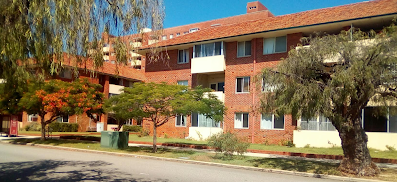Wandana Flats, Thomas Street, Subiaco...Part One.
The ‘Wandana Flats’ at 93 Thomas Street in Subiaco consists of one ten story and two three story buildings built by the State Housing Commission in 1956. The building was designed by Harold Krantz and Robert Sheldon to meet the high needs of post war housing. The gardens were landscaped by John Oldman and included a playground in the inner court and the extensive use of native plants. The complex is on the State heritage listed buildings.
References
Wandana Meaning
“…Wandana - The name was corrupted from the Aboriginal wandunya - ‘iguana water’…”
Reference
https://published.collections.slsa.sa.gov.au/placenamesofsouthaustralia/W.pdf
State Heritage Office.
“…One ten story and two three story blocks, of 242 apartments….”
“…Designed by Krantz and Sheldon and built for 455,000 pounds by State Housing Commission in 1956, this was the first multi-storey housing block built in WA. It was officially opened on 15.3.1956 by the Minister for Housing, Herb Graham. The apartment block was built due to a high demand for housing in Perth after WWII. For more detail refer to HCWA's Assessment Documentation of Places for Entry in the Register of Heritage Places.
The work of Harold Krantz and Robert Sheldon became synonymous with the design and construction of many flats and apartments in Perth from the mid 1940s, producing mass housing that required a minimum of maintenance at affordable prices. Krantz and Sheldon demonstrated an architectural style that followed the principles of Modernism; simplistic, functional and economic with clever use of space and materials. In a period of about 30 years Krantz and Sheldon designed the majority of the flats built in Perth. (Ref: Interview with George Sheldon, Feb 2001)…”
The earliest development in the Triangle was, naturally, closest to the Hay Street commercial centre. Churchill Avenue and Barker Road, and the side streets such as Axon Street, Townshend Road, Olive Street and Coghlan Road, were mostly developed by 1905. Development then spread into the central area between Bagot and Heytesbury Roads by 1915, followed by the southern portion, along Thomas Road.
One of the first land releases was Berry Brow Estate which extended from Rokeby to Townshend Roads, between Hay St and Barker Road. It was marketed as the 'Toorak of Perth.' Others were Bowral Park (1896), the north east corner of the Triangle around Barker and Coghlan Roads, and Parkerville Estate, the stretch of Townshend Road between Barker and Bagot Roads. The area has always been predominately residential, and indeed, the Triangle gained a reputation in the early days as being a prestigious area - workers settled along the railway line, and the more affluent moved up the hill to what was perceived as the better part of Subiaco.
One of the earliest public buildings in the area was the Home of the Peace, on Hamersley Road and Thomas Street, which opened in 1902. Other public buildings include St Andrew's and St Catherine's churches.
Thomas Street was gazetted by 1883, and named after Mr J H Thomas, Director of PWD.
(Sources: Wise's Post Office Directory 1905-1925; Real Estate Maps, Battye Library Collection; Spillman, Ken, Identity Prized: A History of Subiaco, City of Subiaco, UWA Press, 1985, p. 74; Chate, A, H., History of Subiaco, c1952; Moore, D., Subiaco - Attitudes and Ecological Succession, no date, c 1980.)
Reference
Government of Western Australia. State Heritage Council
http://inherit.stateheritage.wa.gov.au/Public/Inventory/Details/55fab9ff-2eee-41d5-bd71-db8472318b37
Reference
City of Subiaco - Local Government Inventory Place Record.
Reference
https://www.subiaco.wa.gov.au/getmedia/5e34b3aa-4101-49fe-b5f3-e511c0dbfe70/Heritage-Place-Record-93-Thomas-Street-(Wandana-Flats)-Subiaco.aspx
Reference
A Thermatic History of Government Housing in Western Australia…Prepared for the Department of Housing.
The Wandana housing complex within the context of the history of State Government housing within Western Australia.
“…The Commission’s first significant venture into multiple flat dwellings was at ‘Wandana’, Subiaco, beginning in 1954. Despite some public controversy about the move, SHC asserted that ‘no city in the world has been able to develop without the supplementary use of multiple flat dwellings and it was particularly important to meet the needs of couples and smaller families. The three-storey block was to be ready by 1955 and the ten storey block, containing 242 flats, was occupied in 1956.
The site was seen as a perfect location for flats, being walking distance from the city and overlooking Kings Park, in a fully serviced area.
Wandana was designed for the SHC by Krantz & Sheldon. Defending the SHC’s choice to build flats, Harold Krantz wrote in 1953 that ‘properly controlled flats projects … will never deteriorate into slums’ as ‘slums develop from properties which cannot be adequately maintained because of low returns’.
Krantz & Sheldon remained the predominant designers of flats in Perth through to the 1970s, with some estimates suggesting the firm designed as much as 90% of Perth’s flats up to this time. In response to limits on building materials, and to keep maintenance to a minimum, their designs pursued functionalism and included features such as minimal decoration, unpainted timbers, face brickwork, cream painted finishes…"
"...Wandana was landscaped by John Oldham, including a children’s playground in the inner courtyard, and extensive use of native plants.558 Use of native vegetation was characteristic of Oldham’s landscape designs. He was one of the founders of landscape architecture as a profession in Australia. Wandana was one of his first commissions as a landscape architect. From 1959, Oldham was the State’s first Government Landscape Architect, employed by the PWD. His government work included landscaping schools, hospitals, dams and the Narrows freeway interchange.559 He was involved in the garden design of several SHC apartment complexes.
With the success of Wandana at Subiaco, smaller two- and three-storey blocks of flats were erected at White Gum Valley, North Fremantle, Como and South Perth. In country areas, the Lotteries Commission assisted with establishing some SHC flats. 560 At North Fremantle, four three-storey apartment blocks were erected at Rocky Bay in 1956-58 (Myuna Flats)….”
Other References
Spillman, K, 1986. Tails of a Singular City. Subiaco since the 1970’s. City of Subiaco.
State Library of Western Australia, 1986. Wandana Flats (6 photographs).






